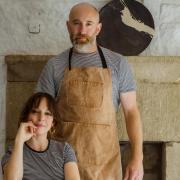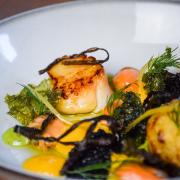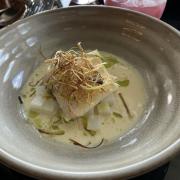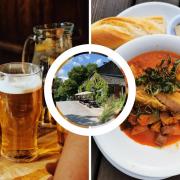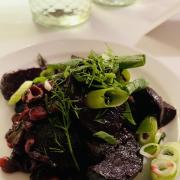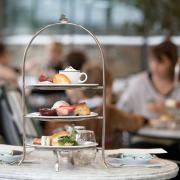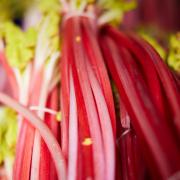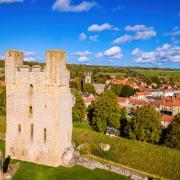Forage for some delicious dishes with expert help from Annie Stirk

You have probably noticed the huge interest in foraging for all kinds of wild food including fruits, nuts and berries. And there is no doubt that there is something about the damp woody smell and the crunch of the leaves in the autumn that’s tempting everybody into the great outdoors for ‘free’ fungi – however, we are still not quite as obsessed as the French and Italians.
The mushroom season is relatively short and you need to be quick off the mark to safely pick and identify any edible specimens and here‘s where you might come unstuck - as there is a very fine line between delicious or deadly. The good news is that there are several experts in Yorkshire who offer guided fungi forages. I wouldn’t want to spoil your fun but it’s best not to attempt to pick any wild mushrooms without this expert help.
Check out Thorpe Perrow Arboretum’s Fungus Forays on October 5th and 19th and November 2nd with Dr Keith Thomas. No need to book but take a bag or a basket. See thorpperrow.com
Also Chris Bax is Yorkshire’s fungi and wild food expert extraordinaire. See tastethewild.co.uk
Have fun foraging.

Know your mushrooms
• We spend at least £304.3 million on mushrooms, eating our way through an amazing 113,804 tonnes or so a year. A huge percentage of this is made up of white mushrooms.
• Eastern cultures revere mushrooms as both food and medicine. More than 50 species are thought to have healing properties. There are medicinal mushroom teas and soups as well as tonics and elixirs.
• Animal, vegetable or mineral? In the case of mushrooms the answer is none of the above, for they are the fruiting bodies of fungi, and fungi are not plants but have a kingdom of their own.
• Mushrooms are nurtured through a six to eight week cycle in environmentally controlled rooms in beds layered like ship’s bunks.
• White and brown mushrooms are picked at four different stages of growth – button mushroom (first stage), closed cup mushroom (second phase), open cup mushrooms (third stage) and large flat mushrooms (fourth stage). A button mushroom, if not picked, doubles in size every 24 hours.

• Mushrooms are considered by some to be a superfood with one of the highest levels of antioxidants on a par with red peppers and spinach.
• Mushrooms are a source of many important vitamins and minerals including B vitamins, iron, potassium and selenium.
• Most mushrooms are best stored in a paper bag in the salad draw of the fridge for a few days.
• Mushrooms are like little sponges, so if you do need to clean them just use a damp kitchen towel – do not soak in water.
Button mushrooms
The most common type of mushroom. They have creamy white caps with pink gills which darken to beige as they grow.
Ceps
Known as cèpes in France and porcini in Italy, these creamy-yellow mushrooms have a good flavour and a velvet-like texture. They are quite meaty and have a spongy underside, rather than gills.
Chanterelle
These creamy-yellow mushrooms are a distinctive frilly trumpet shape with a slightly rubbery texture. They have firm flesh with a subtle, fruity flavour.
Chestnut
These have a strong taste with a meaty texture and are similar in appearance to a button mushroom but a darker colour. The mushrooms should be open but not too flat, exposing the pink to dark brown gills on the underside.
Oyster
So called because of their fan-like shape. They grow naturally in woods, in clusters of overlapping tiers but the cultivated varieties are grown on composted wheat straw. They have a subtle flavour and a chewy texture. Oyster mushrooms are commonly grey but yellow and pink ones are also available. However these lose their colour once cooked.
Porcini
Porcini are wild mushrooms native to the Alpine regions of Italy and France (where they are known as caps). They have a distinctive aroma and a rich flavour. Fresh porcini are only available in late summer and autumn so the dried variety is more commonly used. Only a small amount of dried porcini, around 25-50g, is needed to add an intense flavour to a variety of savoury dishes.
Uses: Soaked dried porcini can be added to a variety of savoury dishes in the same way as fresh mushrooms. They are particularly good in pasta dishes, risotto, soups, stews and omelettes. Porcini go particularly well with garlic or fresh herbs such as flat leaf parsley or thyme. The soaking water can be included in risottos, stews and soups.
Store: Keep dried porcini in a cool, dry place and use by the best before date. Once soaked in water use within 2 hours.
Prepare: Pour 175ml boiling water onto 25g porcini mushrooms and soak for about 15 minutes. Drain the mushrooms, reserving the soaking water, and chop or leave whole as desired.
Portabello
These are large mushrooms with a meaty texture and a wonderful aroma and reach up to 10cm in diameter. Portabello mushrooms are also known as field mushrooms.
Shiitake
Pronounced sheetarky, these mushrooms originated in Japan and Korea and are available fresh or dried. Fresh shiitake have firm caps and light brown meaty flesh with a pleasant and distinct flavour that lingers on the tongue. They should be plump with curled-under edges.
Uses: Add to sauces and stocks, wrap in foil with fish, white meat or vegetables, or chop and use in stuffings for poultry, fish or meat.
Store: Place in a paper bag in the salad drawer of the ‘fridge to keep for a few days.
Prepare: There is no need to wash, just wipe with a kitchen towel. Remove the tough stems and slice or leave the mushroom cap whole.




